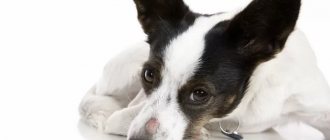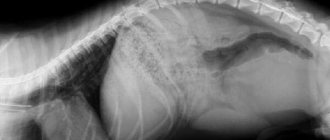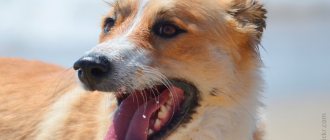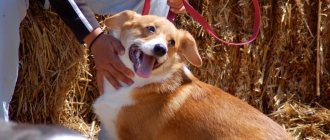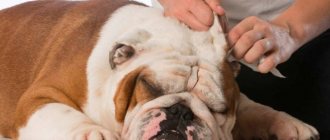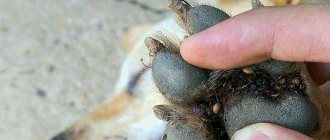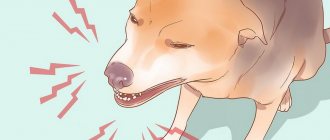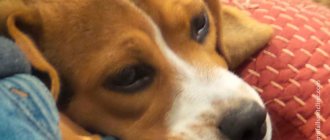Neither man nor animal is immune from disease. If a strange spot, even a small one, is suddenly noticed on your pet’s body, we must be vigilant—lichen in dogs is recognized as a serious disease. We have collected complete information about this insidious disease with answers to all the questions that will bother the owner if lichen is detected in an expensive dog.
What is lichen and where does it come from in domestic dogs?
Ringworm is a disease caused by a fungus or virus that affects the outer layers of the epidermis. Often transmitted by spores upon contact. You can catch it both on the street and at home. Fungi are very tenacious and can remain active even at low or extremely high temperatures.
Any animal or person can become infected. It is believed that living organisms with weakened immune systems, those who have suffered serious illnesses, or those who have aged are especially susceptible to the disease.
Most often, pets catch the disease from their fellow animals while playing or even simply sniffing. There is a risk of infection when using someone else's comb, bowl or bed. Small rodents are also carriers of spores. The fungus can live on any household items or environmental objects.
General signs and symptoms of the disease
It is difficult to recognize the disease in the first stages, because the period of secrecy of the disease can last from 10 to 20 days . The first manifestation of the disease is rashes on the face (usually the nose), ears and tail. They can be expressed by pink or brown spots, redness, bald circular areas, erosions and crusts. A feature of the disease is an increase in the area of affected skin. Therefore, it is important to start treatment immediately.
If medical assistance is not provided in time, the following symptoms will appear:
- Severe itching, irritation, suppuration of wounds;
- Apathy, decreased activity;
- Decreased appetite;
- Hair loss (can spread both locally and throughout the body).
Licking the ointment
Foci of lichen cause severe itching in the pet. With scabies in dogs, the infection spreads to adjacent healthy tissue, which significantly delays recovery. The same thing happens if the animal licks the applied ointment.
If the lesions are single, you can seal them with a plaster or bandage them, after applying a gauze swab with ointment to the skin. It is possible to prevent scratching of large areas using a special collar. If the dog resists such a device and removes it, you should put a jumpsuit on it.
Types of canine lichen and their treatment
Ringworm is classified according to symptoms, type of symptoms and manifestations, and danger of progression. It is important to diagnose a certain type of lichen in time in order to prescribe the correct treatment, so it is important for owners to know the external signs of all varieties.
Ringworm (Trichophytosis)
The most common and dangerous type of disease. Its characteristic feature is the speed of spread. Without the necessary treatment, the disease develops quickly and can be fatal. In addition, it is dangerous for humans, and therefore requires special precautions. Ringworm is caused by the fungi Microsporum and Trichophyton.
The symptoms are described by the name . First of all, the bald spots “cut” by the fungus are clearly visible. The lesions are round, clearly defined, up to 2 cm in diameter. The spots can be pinkish or bright brown. They are usually localized on the tail and limbs, but quickly spread to the body.
Ringworm
A type of lichen that is safe for humans . It is not caused by a fungus or virus. The nature of the disease is a reaction to an allergen. Often a consequence of a hormonal disorder. May be chronic and recurring.
Sometimes such eczema is caused by improper hygiene procedures and the use of low-quality shampoos.
Appears gradually. First, itchy and hot swollen areas appear . Place of distribution: cheeks, neck, croup. After some time, blisters filled with pus form. Hair falls out in affected areas. The bubbles burst and ooze liquid. The wound becomes covered with mucus, which contributes to the formation of crusts. With proper treatment, healthy epithelium appears under the erosions.
Pityriasis rosea
This type is also not dangerous for humans; it is caused by chronic diseases or personal special reactions to external stimuli, such as bacteria . Most often, pets with a genetic predisposition or old and weakened dogs are susceptible to pink lichen. This type cannot be completely cured. It occurs whenever the immune system stops working effectively.
Characteristic features : pinkish spots with a diameter of 2-3 cm in the groin or muzzle area, itching, necrosis of the epidermis - peeling, flaking. The only type of lichen that can go away on its own, however, treatment is still needed to prevent possible spread.
Pityriasis versicolor (lichen versicolor)
The disease received its name due to the nature of the rash . They can be of different colors: from brown-red to pinkish. At the site of inflammation, hair falls out.
The disease is caused by the fungus Malassezia . It lives on all living organisms, but is inactive when the immune system is functioning properly. However, in case of injuries and other deep lesions of the epithelium, the fungus wakes up and releases caustic substances that destroy skin cells and cause lichen. For healthy people this variety is of little danger .
Shingles
A type of lichen caused by the herpes virus . It is called shingles due to the peculiarity of the spread of foci of inflammation. Initially, severe itching appears in the ribs and abdomen. After this, blisters with liquid form on the itchy areas. After a few days they burst and crusts form. If the course is prolonged and left untreated, the lichen will continue to spread throughout the pet’s body. The disease is also transmitted to humans.
Treatment at home - traditional methods
We present traditional medicine recipes for your reference and remind you that all of them do not have proven effectiveness. In addition, uncontrolled use of these products without the advice of a veterinarian can harm your pet. Be careful and attentive!
First method
What you will need:
- disposable medical gloves;
- laundry soap;
- cotton pads;
- iodine.
How to process:
- put on gloves and carefully trim the hair in areas affected by lichen;
- Make a saturated soap solution from laundry soap and warm water;
- treat sore areas with cotton pads, being careful not to hurt the dog;
- After this, treat the affected areas with iodine.
The procedure is repeated daily until the animal recovers. To prevent your dog from licking its wounds, use an Elizabethan collar.
Important!
Remember that iodine is toxic to animals, do not overuse self-medication!
Second method
What you will need:
- disposable medical gloves;
- cotton pads;
- Apple vinegar.
How to process:
- put on disposable gloves and trim the hair around the wounds;
- soak a cotton pad in apple cider vinegar and treat the affected areas;
- repeat the treatment daily until the shingles go away.
This method is only suitable for pityriasis rosea. Other types of pathology are not treated in this way.
Important!
If traditional medicine does not help, be sure to show your pet to a veterinarian, he will tell you how to treat lichen in dogs.
Video
How can you treat lichen in a pet?
Treatment of lichen is carried out in several stages . Initially, after the type of disease is diagnosed, the veterinarian prescribes external antiseptic and antifungal drugs. If the disease is stable, does not affect the lower layers of the epidermis, and does not aggravate the dog’s condition, then treatment is stopped only with the use of ointments, sprays or other means.
In case of severe illness, prolonged lichen, it is important to start taking antibiotics on time . Injectable solutions or tablets may be prescribed. After the course of treatment (and even during), it is important to give your pet immune medications that will stabilize and restore the defense system against viruses.
Folk remedies are often used. But you can’t rely only on them. It is important to consult a doctor in time, determine the type of lichen, and begin the correct treatment.
List of drugs
| Drug name | Price | Description |
| Fungin | 150-170 rubles per bottle | Spray that destroys the structure of the fungus, healing the affected parts of the skin |
| Vedinol | 68-100 rubles | More often used as a wound-healing drug, but also has an antifungal effect |
| Ekalin | Up to 200 rubles | Against yeast and mold fungi, as well as dermatophytes; promotes not only the death of bacteria, but also has an analgesic effect |
| Zoomikol | 350-500 rubles per bottle | Spray for external use; helps in the treatment of candidiasis, mycosis, microsporia and trichophytosis |
| Yam | 70-90 rubles (depending on the gram) | The ointment not only kills the fungus that causes lichen, but also affects the proliferation of bacteria, providing antiseptic properties |
| Mycoseptin | 400-500 rubles per tube | An ointment that promotes the removal of bacteria and fungus from the skin and rapid healing of wounds; affects all types of skin diseases |
| Thiabendazole | 200-250 rubles | An inexpensive ointment that kills all parasitic harmful bacteria, fungi and insects. Has many contraindications |
| Griseofulvin | 200-250 rubles per tube | Antiseptic and analgesic ointment that destroys not only fungi, but also pathogenic diseases |
| Amphotericin | 37-50 rubles per bottle (10 ml) | Antibiotic solution for injection, taken in especially severe cases with deep infections by fungi of any type |
| Griseofulvin | 230 rubles per package (20 pieces) | Tablets for oral use, act like an ointment, are better absorbed, are prescribed for severe forms of lichen diseases |
| Immunofan | 79 rubles per ampoule | Injection solution to strengthen the immune system |
| Cemax | 210-220 rubles per package (100 g of powder) | Feed additive that stimulates the production of immune system cells |
It is worth noting that, despite the effectiveness of treatment with folk remedies, they should only be used in parallel with the main course of treatment, which will be prescribed by a veterinarian. The fact is that different depths and complexity of the disease require variable treatment.
Treatment with folk remedies
The most important auxiliary folk remedies are herbs: chamomile, sage, St. John's wort, tansy. They are used externally to soften dead skin and for antiseptic purposes.
Some dog breeders actively recommend apple cider vinegar solution. It should also be used externally, washing the wounds 5-6 times a day. Machine oil is used in the same way.
Such folk remedies must be handled with extreme caution . Some substances can not only cause irritation, but also provoke an allergic reaction.
Is iodine used to combat ringworm?
The use of iodine in the treatment of any dog disease is twofold. In general, this is one of the most powerful antiseptics, which is capable of drying wounds and burning out all pathogenic accumulations from them.
However, when treating a pet, you should be careful:
- Firstly, Iodine must be diluted so as not to burn the animal or burn the skin.
- Secondly, if the wound is open, then you cannot pour solution into it; treat only the edge to prevent the entry of other bacteria.
What to do if your dog licks the ointment and scratches the sore spot
Wounds always cause discomfort: they cause burning, pain, tingling . The dog may involuntarily itch or lick the sore spot. In the first minutes after use, the ointment can really irritate the mucous membrane. During application of the drug, the animal must be held and not allowed to lie down or dry itself.
The most effective way is to use a protective collar, collar or muzzle . Dogs often don’t like it because it limits their field of vision and immobilizes them. To keep your pet from getting upset, you can treat him with a treat or take him for a walk .
Nutrition and care of the dog during the treatment of lichen
During treatment, nutrition should be complete, containing all the necessary vitamins. If your pet is accustomed to dry food, then it is worth choosing a medicinal type. Immunostimulating additives (powder) are mixed into the food . Natural foods should contain a lot of protein to speed up the healing process.
Caring for a dog consists of several important points:
- The first is regular wound treatment. To do this, you need to apply a special ointment, spray or solution according to the instructions (at least 4 times a day) using a spatula or a cotton swab. In addition, you need to wash the skin with herbal decoctions and remove skin crusts.
- The second point of care is daily wet cleaning and changing bedding. It is necessary to disinfect the room using spray antiseptics. Dishes and toys are washed and washed daily. It is important to exclude direct contact of the pet with household members and other animals, and to reduce the walking time. A protective collar is worn during procedures.
Speed up recovery
The main condition is strict adherence to the recommendations of the veterinarian.
The animal must be given medications in strict accordance with the prescribed course and dosage, without skipping doses. Unauthorized replacement of one medication with another, or termination of therapy ahead of schedule is not allowed. The dog owner should be prepared for the fact that sometimes treatment can take a month or more.
Treatment with special shampoos that contain antifungal components will help speed up your pet’s recovery and prevent the spread of infection. Grooming products are gentle on the surface of the skin, but cannot be used for a long time. To avoid excessive dryness of the epidermis, follow the instructions.
Danger to humans and pets
Only certain types of lichen can be transmitted to people or other animals. The biggest threat is ringworm. It is extremely contagious, so it is important to quarantine. Ringworm is completely safe because it does not spread through contact.
Pityriasis rosea can be dangerous if the immune system is weakened due to the disease . However, debate about its contagiousness still circulates among specialists. In any case, you shouldn’t be afraid of it, but it’s better to follow all hygiene standards. The situation is similar with pityriasis versicolor. Usually, it does not apply to people or other pets. But if the body’s resistance is greatly reduced, there is a possibility of infection.
Methods for preventing and diagnosing the disease
Diagnosing lichen is simple; it is more difficult to determine its type. As a rule, the symptoms indicate which fungus caused the disease, but it is better to consult a veterinarian. The clinic will prescribe laboratory tests, for example, a smear or scraping of the skin, diagnosis of keratinized cells, skin biopsy, fur culture, Wood's lamp examination . After this, the doctor will determine which treatment is suitable in a particular case.
Of course, it is easier to prevent a disease than to cure it later. To do this, you need to follow preventive measures:
- It is important to prevent your pet from free-ranging and from contact with stray or infected animals;
- Carrying out regular hygiene procedures: bathing after walks, wet cleaning of the room, washing the bed and other pet things;
- Compliance with diet and vitamin supply;
- Effective treatment of any disease to avoid weakening of the immune system;
- Regular treatment for external parasites;
- Inspection of fur and skin at least 3-4 times a week.
In addition, you need to vaccinate your pet against lichen every year. It can be done even to infected animals in case of severe disease.
Any dermatitis can cause a bacterial disease or fungal infection. Therefore, you should not turn a blind eye to rashes, wounds and even minor damage to the skin. Ringworm is an insidious disease that is difficult to protect against.
5 / 5 ( 2 voices)
Conservative therapy
If signs of illness appear, the dog should be taken to a veterinarian.
The disease is diagnosed using a Wood's lamp. The fungus is not always detected by ultraviolet light. A microscopic examination of biomaterial from the affected skin will be required. The dog's blood and urine are submitted for laboratory analysis. It is important not to confuse lichen with other dermatological diseases. Dermatitis, eczema, and folliculitis have similar symptoms.
It will be necessary to use drugs that have an antifungal effect. Local treatment will require removing hair from the affected area. The animal will have to be washed regularly with medicated shampoos.
Take the Attention Test! Find 10 differences! (click right here!)
Find the answer Are you bothered by some problem or question? Enter “Breed” or “Name of the problem” into the form, press Enter and you will find out everything about the issue that interests you.
The goal of therapy is to:
- The cause of the disease was eliminated;
- No secondary infection occurred;
- Eliminate itching, pain;
- Strengthen your immunity.
Antifungal and anti-inflammatory substances are applied externally. They come in the form of ointment, cream, spray, powder. For internal use, tablets and injections are prescribed. The veterinarian may prescribe vitamins, probiotics, and antihistamines.

